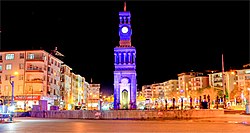Kırıkkale
Kırıkkale | |
|---|---|
 | |
 Kırıkkale | |
| Coordinates: 39°50′30″N 33°30′50″E / 39.84167°N 33.51389°ECoordinates: 39°50′30″N 33°30′50″E / 39.84167°N 33.51389°E | |
| Country | Turkey |
| Province | Kırıkkale |
| Government | |
| • Mayor | Mehmet Saygılı (AKP) |
| Area | |
| • District | 318.07 km2 (122.81 sq mi) |
| Population (2012)[2] | |
| • Urban | 192,473 |
| • District | 200,625 |
| • District density | 630/km2 (1,600/sq mi) |
| Website | www.kirikkale.bel.tr |
Kırıkkale is the capital of the Kırıkkale Province in the Central Anatolia region of Turkey. It is located 80 km east of Ankara. According to the 2000 census, the population of the province is 280,834, of which 192,705 live in the city of Kırıkkale.[3][4] The name of the city means broken castle.
The town of Kırıkkale is located on the Ankara-Kayseri railway near the Kızıl River in central Turkey. Formerly a village, it owes its rapid rise in population mainly to the establishment of steel mills in the 1950s. These works, among the largest in the country, specialize in high-quality alloy steel and machinery. In the 1960s, chemical plants were added and in 1986, the Tüpraş Kırıkkale Oil Refinery was established.
Kırıkkale University is located in the city.
History[]
The name of the city supposedly comes from the name "Kırık" a village 3 km north of the city combined with another name called "Kale", meaning castle, in the centre of the city, the two were put together to make 'Kırıkkale'. Inhabitation began in the 16th century when Turkish tribes came from the east and settled in Central Anatolia. [5]
Geography[]
Kırıkkale was recently declared a state in the Central Anatolia region of Turkey which is near Kızılırmak River translating to Red River. The river is used to produce rice for the Turkish economy. The natural vegetation is steppe type, and vineyards are found in abundance.[5]
Climate[]
Kırıkkale has a cold semi-arid climate (Köppen: BSk) or a continental climate (Trewartha: Dc).[6] Winters are cold and moderately snowy, whereas summers are hot and dry. Rainfall is most common during spring and autumn.
| hideClimate data for Kırıkkale (1991–2020, extremes 1963–2020) | |||||||||||||
|---|---|---|---|---|---|---|---|---|---|---|---|---|---|
| Month | Jan | Feb | Mar | Apr | May | Jun | Jul | Aug | Sep | Oct | Nov | Dec | Year |
| Record high °C (°F) | 17.0 (62.6) |
21.4 (70.5) |
30.4 (86.7) |
32.0 (89.6) |
36.0 (96.8) |
37.6 (99.7) |
41.8 (107.2) |
40.3 (104.5) |
40.6 (105.1) |
33.5 (92.3) |
24.8 (76.6) |
19.0 (66.2) |
41.8 (107.2) |
| Average high °C (°F) | 4.7 (40.5) |
7.8 (46.0) |
13.2 (55.8) |
18.7 (65.7) |
23.8 (74.8) |
28.2 (82.8) |
31.8 (89.2) |
31.9 (89.4) |
27.7 (81.9) |
21.4 (70.5) |
13.0 (55.4) |
6.3 (43.3) |
19.0 (66.2) |
| Daily mean °C (°F) | 0.8 (33.4) |
2.7 (36.9) |
7.2 (45.0) |
12.2 (54.0) |
17.1 (62.8) |
21.4 (70.5) |
24.9 (76.8) |
24.9 (76.8) |
20.3 (68.5) |
14.4 (57.9) |
7.0 (44.6) |
2.4 (36.3) |
12.9 (55.2) |
| Average low °C (°F) | −2.4 (27.7) |
−1.4 (29.5) |
2.0 (35.6) |
6.1 (43.0) |
10.7 (51.3) |
14.5 (58.1) |
17.6 (63.7) |
17.7 (63.9) |
13.1 (55.6) |
8.3 (46.9) |
2.2 (36.0) |
−0.6 (30.9) |
7.3 (45.1) |
| Record low °C (°F) | −22.4 (−8.3) |
−21.6 (−6.9) |
−19.8 (−3.6) |
−6.8 (19.8) |
0.4 (32.7) |
4.6 (40.3) |
7.4 (45.3) |
7.2 (45.0) |
2.7 (36.9) |
−5.0 (23.0) |
−9.7 (14.5) |
−18.0 (−0.4) |
−22.4 (−8.3) |
| Average precipitation mm (inches) | 42.8 (1.69) |
30.2 (1.19) |
39.1 (1.54) |
40.0 (1.57) |
50.2 (1.98) |
42.3 (1.67) |
9.6 (0.38) |
14.4 (0.57) |
15.0 (0.59) |
29.1 (1.15) |
30.6 (1.20) |
43.6 (1.72) |
386.9 (15.23) |
| Average precipitation days | 11.57 | 9.93 | 11.03 | 11.87 | 13.37 | 9.83 | 3.50 | 3.57 | 4.73 | 7.50 | 8.00 | 11.27 | 106.2 |
| Mean monthly sunshine hours | 83.7 | 121.5 | 170.5 | 216.0 | 269.7 | 312.0 | 359.6 | 341.0 | 270.0 | 207.7 | 141.0 | 74.4 | 2,567.1 |
| Mean daily sunshine hours | 2.7 | 4.3 | 5.5 | 7.2 | 8.7 | 10.4 | 11.6 | 11.0 | 9.0 | 6.7 | 4.7 | 2.4 | 7.0 |
| Source: Turkish State Meteorological Service[7] | |||||||||||||
Notes[]
- ^ "Area of regions (including lakes), km²". Regional Statistics Database. Turkish Statistical Institute. 2002. Retrieved 2013-03-05.
- ^ "Population of province/district centers and towns/villages by districts - 2012". Address Based Population Registration System (ABPRS) Database. Turkish Statistical Institute. Retrieved 2013-02-27.
- ^ "Adrese Dayalı Nüfus Kayıt Sistemi (ADNKS)-Nüfus Sayımı Sonuçları" (in Turkish). Archived from the original on 20 September 2015. Retrieved 6 September 2010.
- ^ GeoHive. "Statistical information on Turkey's administrative units". Retrieved 2008-03-19.
- ^ Jump up to: a b "Web Hosting Control Panel Login". www.allaboutturkey.com.
- ^ Öztürk, Mehmet Zeynel; Çetinkaya, Gülden; Aydın, Selman. "Köppen-Geiger İklim Sınıflandırmasına Göre Türkiye'nin İklim Tipleri/Climate Types of Turkey According to Köppen-Geiger Climate Classification". Coğrafya Dergisi – Journal of Geography. 35 (2017): 17–27. doi:10.26650/JGEOG295515. Retrieved 23 June 2020. (in Turkish and English)
- ^ "Resmi İstatistikler: İllerimize Ait Mevism Normalleri (1991–2020)" (in Turkish). Turkish State Meteorological Service. Retrieved 6 July 2021.
References[]
- Falling Rain Genomics, Inc. "Geographical information on Kırıkkale, Turkey". Retrieved 2008-03-16.
External links[]
| Wikimedia Commons has media related to Kırıkkale. |
- Kırıkkale
- Cities in Turkey
- Districts of Kırıkkale Province

